




OUR BEST EVER OFFER - SAVE £100/$100
JOIN THE WORLD'S LEADING PROFESSIONAL DEVELOPMENT PROGRAMME
- 12 months membership of Elite Soccer
- Print copy of Elite Player & Coach Development
- Print copy of The Training Ground
Sustaining Attacks
This session is about creating attacks whilst ensuring we have a good attacking structure as a team to counter press if we lose the ball.
| Area | Up to half a pitch |
| Equipment | Balls, bibs, mannequins, 2 full size goals |
| No. of Players | Up to 20 + 2 goalkeepers |
| Session Time |
Positional possessions: 16mins |
This session is about creating attacks whilst ensuring we have a good attacking structure as a team to counter press if we lose the ball.
We then look to sustain pressure and create further opportunities by our aggressive positioning.
We would mainly use this session in preparation for a game in which we would expect to have good possession in the opposition half against a low block. We would work this session 2-3 days before a matchday and would manage the timings depending on the workload we desired.
This session is made up of three practices. Firstly, a positional possession. We run these possessions regularly as we like to see the players perform in their positions and build good relationships and connections throughout the team by working consistently. These practices can be a good lead into any tactical phased work.
The second part is an unopposed attacking drill, and we finish with an attack versus defence drill to see the players apply these methods in a more active way.
“We run these possessions regularly as we like to see the players perform in their positions and build good relationships and connections throughout the team by working consistently”
POSITIONAL POSSESSIONS
The players will have performed a strenuous physical warm-up passing drill before we begin.
We set up a playing area of 40m in length and 30m in width (this area can be varied depending on technical demand and desired physical outcome).
We use the 20 outfield players set up in 4-3-3 formations – in this instance we have a blue team and a red team. We make the number 6 of both teams neutrals, to overload the central area of the pitch which creates a 10v8 for the team in possession.
This encourages the blue team to use the central overload with particular focus on the 6’s role in circulating the ball.
The aim of this practice is to work on the positional relationships within the 4-3-3 system. By repeating this type of exercise, the players can gain a clear understanding of their individual roles and how we want them to move within the team structure.
The possession is multidirectional in terms of how we want the ball to move. The players should stay disciplined within their roles and all movement should effectively be short distances, to create angles and passing options whilst stretching the playing area as a team whilst in possession.
The blue team will start with the ball and must try to keep possession whilst under pressure from the reds [1a, 1b]. If the reds win the ball, it is their turn to keep possession.
[1a]
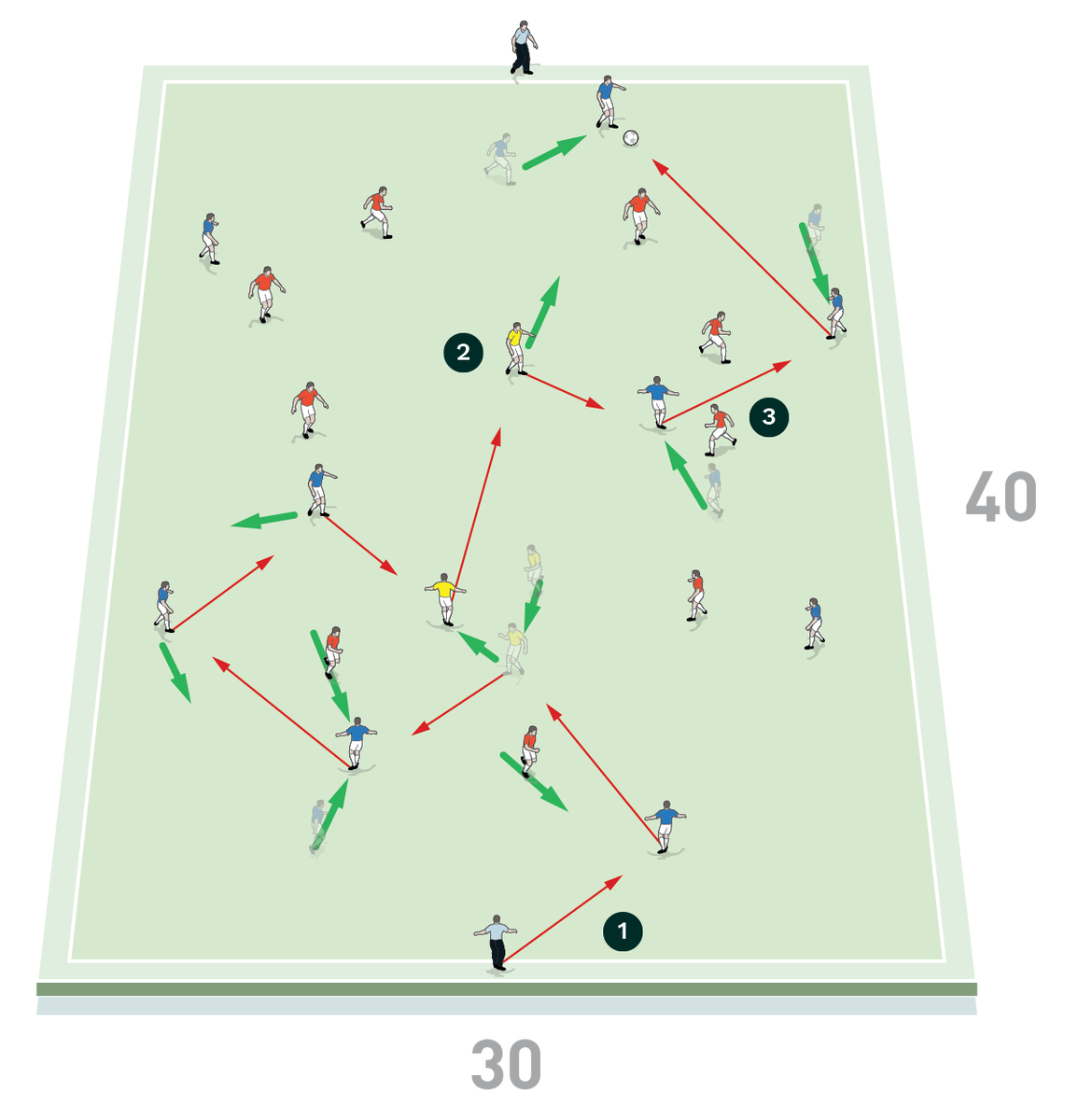
-
The coach plays the ball in to the blue team
- The blue team aim to keep possession, using the neutral number 6s to create a central overload and creating triangles to offer options
- The reds press to win the ball back
The blues must react quickly in the first instance to counter press and win the ball again by closing at speed as a team.
[1b]
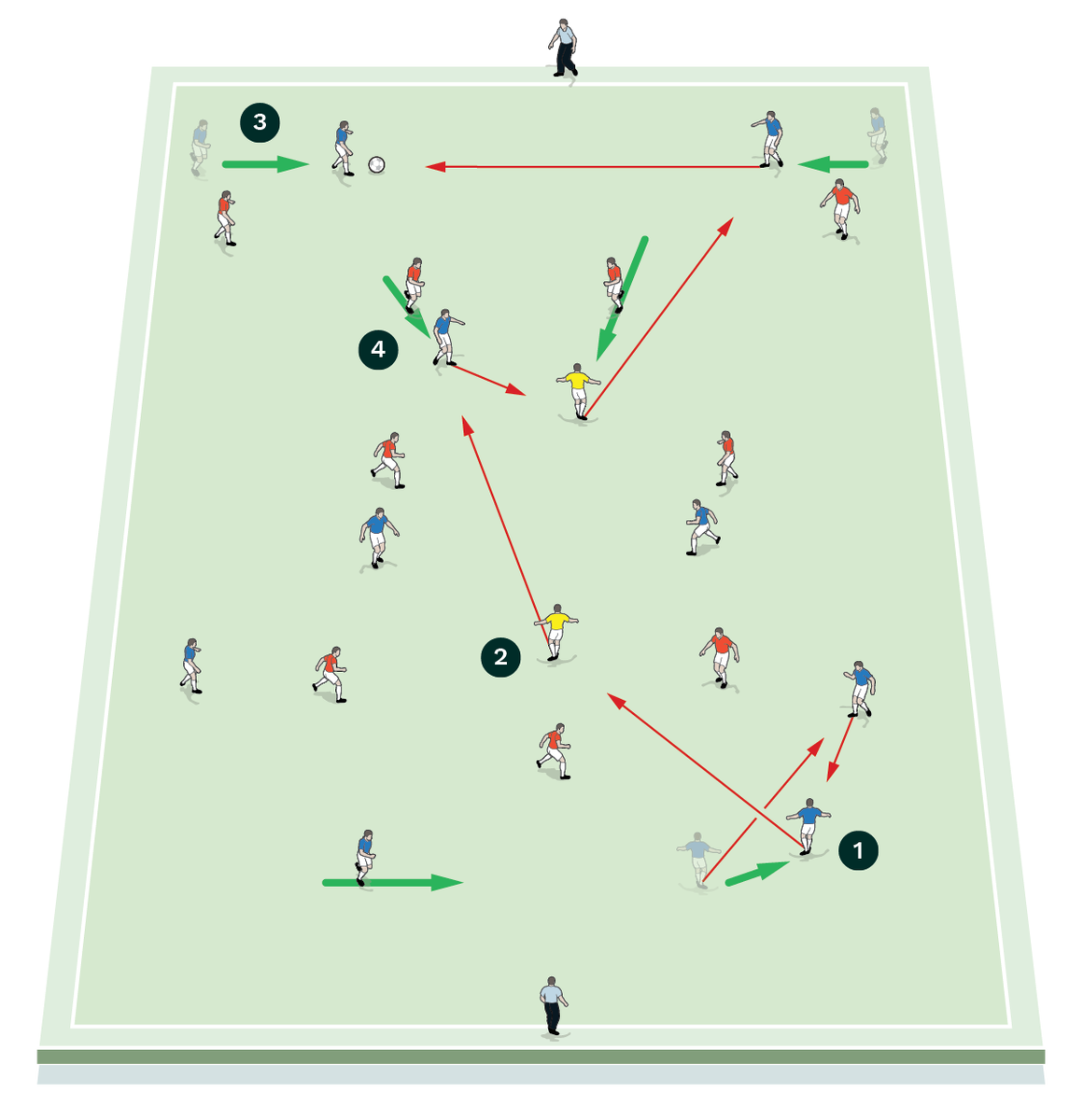
-
The blue team have possession
- The defenders play the ball into the number 6, who turns and plays it forward
- The wingers and striker rotate to create options
- The reds press to win the ball back
“The aim of this practice is to work on the positional relationships within the 4-3-3 system”
The reds must open quickly to maximise the area and use the central overload to move the ball from front to back and side to side [1c].
[1c]
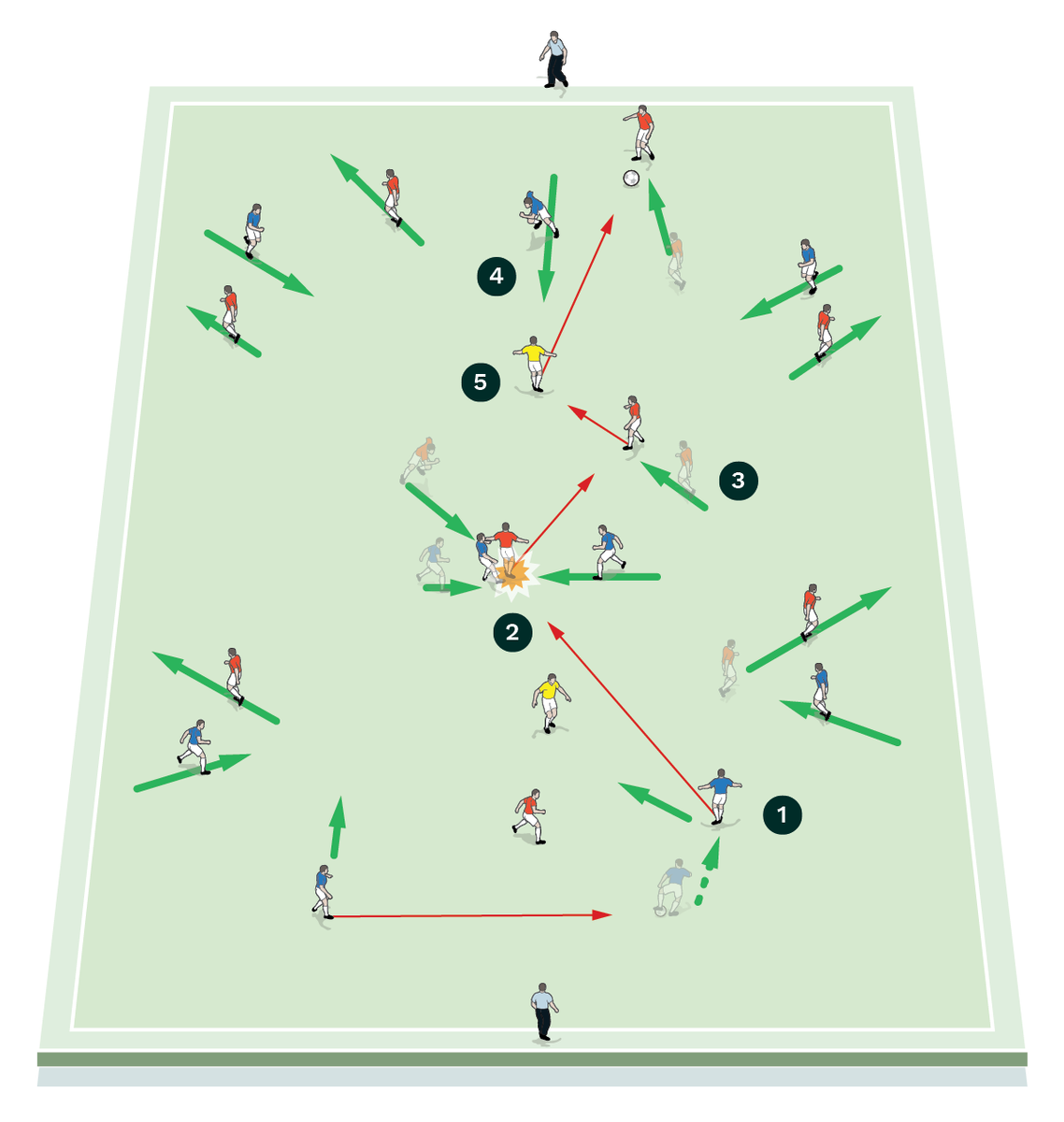
-
The blue team combine centrally
- The reds press and win it back in midfield
- The reds now look to keep possession by opening quickly to maximise the area
- The blues react quickly to counter press and close at speed as a team
- The reds use the central overload to move the ball
When the ball goes out the coach at either end will restart for the team in possession.
We would look to work four blocks of four minutes work. We would start with three touches for all and then reduce touches as the coach sees fit for different blocks.
Often, we finish the last block with one touch for the players and two touches for the neutrals. This allows the neutral players to control the rhythm of the play centrally.
Unopposed attacking patterns
We set up on half a pitch with a goal and a goalkeeper at one end. We place four mannequins outside the penalty area to represent a back four. They should span the width of the box. We mark out two lines that run from the width of the box to the halfway line.
Our two teams will continue in their initial 4-3-3 set-up and will work in rotation towards the goal from the halfway line.
Our first sequence of attacks for the blue players will involve three phases and will create three chances on goal. The red players will rest either on a mannequin or to the side of the pitch.
We have one coach behind the play to feed the first ball, and another in the centre of the half to feed balls two and three.
The first attack sees the blues set up in a 2-3-2-3 formation. We want to see the five players at the base of the team (in this instance, two centre-backs, two full-backs plus number six) staying inside the width of the boxes. The wingers provide width, and the striker will work centrally close to the back-four line.
Often, we would work prescribed sequences to goal in this type of practice. In this instance we ask the players to move the ball freely but to keep their positional discipline until we attack. This means players make constant angles and connections as they build and switch the play. At the right moment, the players will combine past the defensive line to create a crossing opportunity [2a].
[2a]
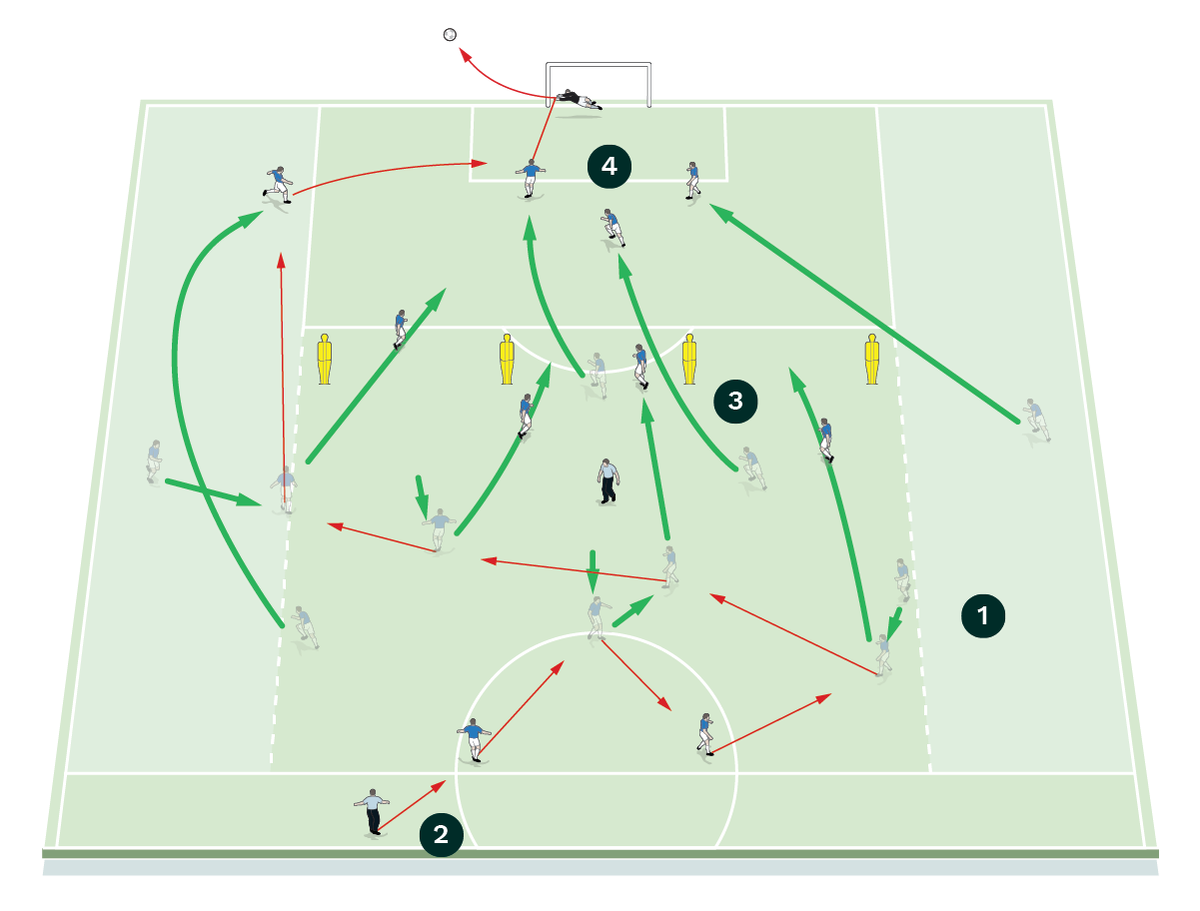
-
The blues are set up in a 2-3-2-3 formation
- The coach off the pitch feeds the first ball
- The team play the ball through a prescribed sequence. They are asked to move the ball freely but keep their positional discipline until attacking
- The players combine past the defensive line to create a crossing opportunity
Once the chance has been taken, the whole team will have moved up into high positions and as the attacking players recover towards position, the other coach will start attack two with a ball played to a high positioned centre-back. The ball will be moved quickly to either wide zone for either a winger or an advancing full-back to cross for the second chance at goal [2b].
[2b]

-
Following the chance, the whole team is now in high positions
- As the attacking players recover towards position, the coach on pitch starts the second attack with a ball to a high-positioned centre-back
- The ball is moved quickly to the wide zone for a winger or advancing full-back to cross
The same coach will then release a quick final ball just outside the box for a shot or quick central combination to goal [2c].
[2c]
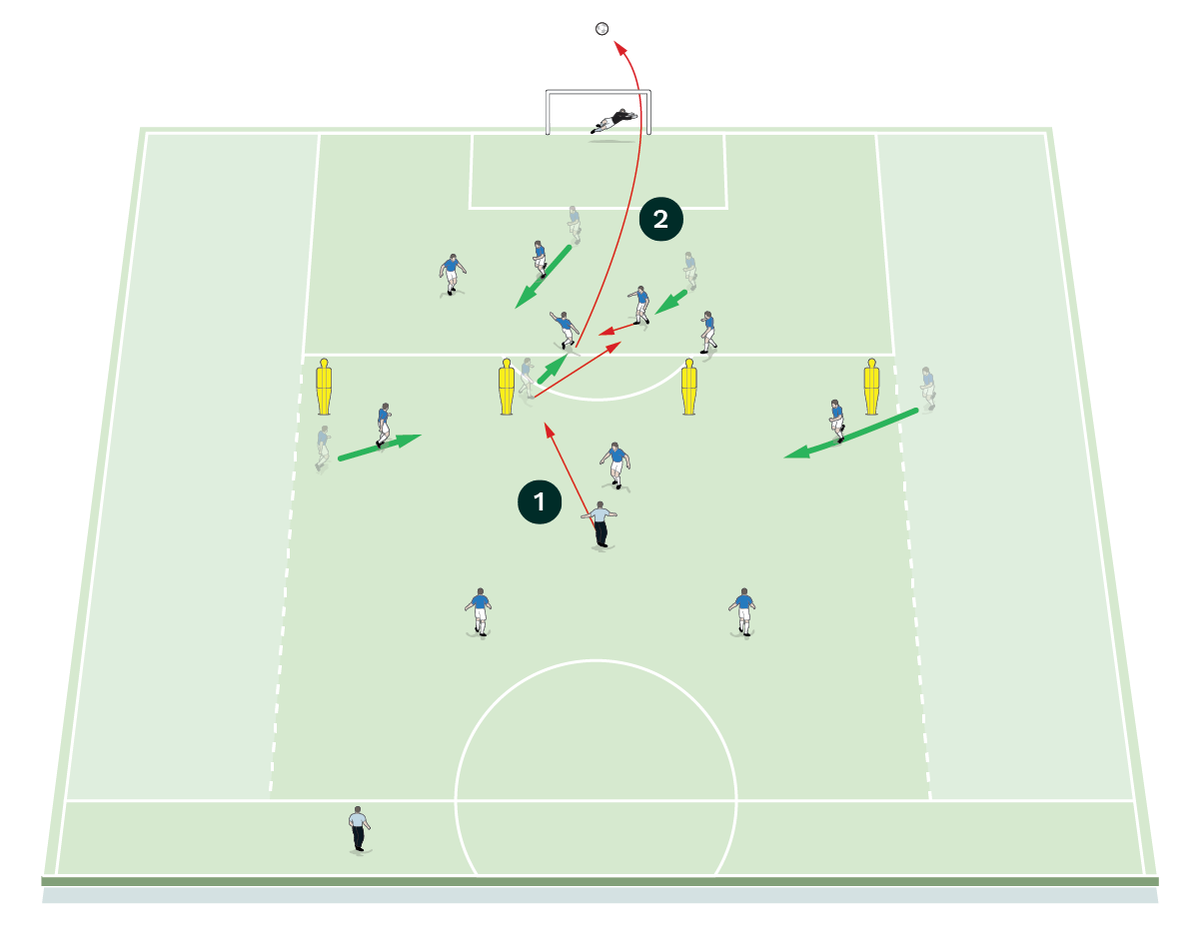
-
Once the chance has been taken, the coach on pitch releases a quick final ball outside the box
- The team combines centrally and shoots at goal
After this final shot the blues will rest and the reds will step in to play. We keep alternating and run the practice for 20-25 minutes.
We can progress the first phase of this practice by adding two or three shadow defenders in the passing build up. We can also change the starting positions of the players. For instance, we drop a midfielder lower and advance a full-back, so the players are able to become comfortable with rotations and understand their responsibilities.
Attack v defence
To finish the session, we run a half-pitch attack v defence to goal, with a green zone five metres inside the half.
We use an attacking blue team of 10 outfield players in a 4-3-3 formation, who will attack the opposition of eight in a 4-2-2 formation (we have removed the wingers from the red team).
We can run this part as a 10v10 but we choose this to enhance the attacking success of the blue team. This should help us to see the movements and behaviours we have been working on.
We particularly want to see switches of play to find spaces on the opposite side of the pitch as the reds move across, threats to the back line with repetitive movements, and lots of crosses from optimum areas, with good box occupation and counter press positions.
The coach starts the practice from the halfway line and all restarts will be for the blue team for the first block of work. The aim is for the blue team to continuously attack, create chances and to sustain attacks in the way that we have been working on [3].
[3]
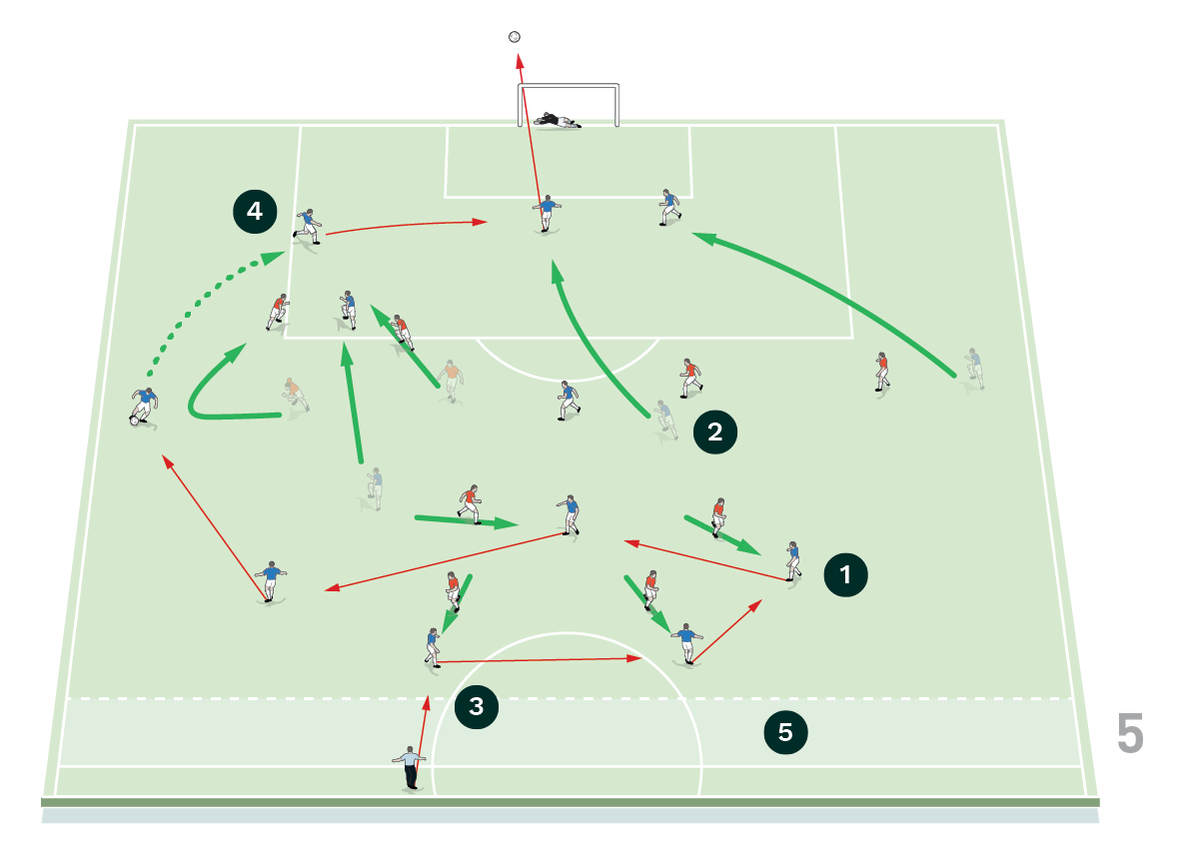
-
Blues are set up in a 4-3-3 formation
- Reds are set up in a 4-2-2 formation
- The coach starts the practice from the halfway line
- The blues must continuously attack, create chances and sustain attacks
- If the reds win the ball, they try to make six passes or enter the green zone
When the reds win the ball, they try to make six passes and/or enter the green zone. At this point, the coach stops the practice before restarting for the blues.
After 10 minutes of work, we change the teams and work the second block with the 10 reds attacking the eight blues for 10 minutes.
In this final practice we want to see all the team and individual movements we have focused on in the session.
COACHING POINTS
What are the key things to look out for?
In the positional possessions practice, our focus is on the possession team and the counter press reactions of both. We want the players to use the central overload to circulate the ball from back to front and side to side. We do not want to stay in one area for too long and invite pressure. We want to see good connections, so lots of good active angles and passing options.
Distances between players should be generally short so we can make quick passes to play through or around the pressing team. The best pass for us is a central pass to a free player who can turn and play through to the other side. If players can’t turn, we want quick combinations through pressure to switch the play.
When the pressing team blocks the middle, we want to quickly play around the sides, making sure we do not get stuck in these areas.
Another focus is to control the tempo of the play. Players must understand the times to wait and commit pressing players, or to play fast to find the free players/space. We are not so focused on the defensive team on an in-possession day, but we do expect the pressing team to display our consistent off-the-ball behaviours.
They should be compact, try to block the middle of the pitch and press with intensity.
We do focus on the defensive transition for both teams. When they lose the ball, they must react quickly and aggressively to block the first passing lines and close as a team.
In the unopposed attacking patterns practice, we want to see a good balance from the team in the first phase. Positionally, we should keep central control as we build play, high width on both sides, with attacking players ready to attack the back line with different movements.
We expect quick short phases as we build with a three-touch maximum, and the ball should move from side to side until we find the right moment to attack. We would work high attacking patterns regularly, so the players have freedom to find the right timing and inject speed into the attack at the right time as they see fit.
“The best pass for us is a central pass to a free player who can turn and play through to the other side. If players can’t turn, we want quick combinations through pressure to switch the play”
The phase normally ends with a cross with good box occupation and a high counter press position from the whole team.
For the second phase we want the ball to move wide quickly for a quality crossing opportunity, then phase three is a central shot. We focus on the speed of these attacks and being clinical with the final action.
What are the typical mistakes players might make and how do I avoid them? What can go wrong?
In the positional possessions practice, the in-possession team can reduce the playing area by having all attacking players coming towards the ball. This makes it easier for the pressing team to close spaces and win the ball back. At least two attacking players should try to stretch the pitch and the opposition pressing structure.
Players without pressure can play long passes too early that are ‘pressable’ passes to players without support. These are times to wait and allow your team-mates to adjust their angles and give better options.
The technical demand in tight spaces can cause regular turnovers. Players must not get disappointed and must make sure they keep reacting at speed to the transition. The coach can affect this by increasing the size of the playing area, if needed.
In the unopposed attacking patterns practice, the ball can move too slowly, and there may be technical mistakes in the build-up. The timing of the high attacking movements can be off.
Positional behaviours may not be right. Wingers drop too deep or counter press positions aren’t aggressive enough, for example.
All these things are normal, so we will actively try to correct the details as we progress.
Related Files
Editor's Picks
Attacking transitions
Deep runs in the final third
Using the goalkeeper in build-up play
Intensive boxes drill with goals
Penetrating the final third
Creating and finishing
My philosophy
Pressing initiation
Compact team movement
Coaches' Testimonials

Alan Pardew

Arsène Wenger

Brendan Rodgers

Carlos Carvalhal

José Mourinho

Jürgen Klopp

Pep Guardiola

Roy Hodgson

Sir Alex Ferguson

Steven Gerrard
Coaches' Testimonials

Gerald Kearney, Downtown Las Vegas Soccer Club

Paul Butler, Florida, USA

Rick Shields, Springboro, USA

Tony Green, Pierrefonds Titans, Quebec, Canada
Join the world's leading coaches and managers and discover for yourself one of the best kept secrets in coaching. No other training tool on the planet is written or read by the calibre of names you’ll find in Elite Soccer.
In a recent survey 92% of subscribers said Elite Soccer makes them more confident, 89% said it makes them a more effective coach and 91% said it makes them more inspired.
Get Monthly Inspiration
All the latest techniques and approaches
Since 2010 Elite Soccer has given subscribers exclusive insight into the training ground practices of the world’s best coaches. Published in partnership with the League Managers Association we have unparalleled access to the leading lights in the English leagues, as well as a host of international managers.
Elite Soccer exclusively features sessions written by the coaches themselves. There are no observed sessions and no sessions “in the style of”, just first-hand advice delivered direct to you from the coach.



